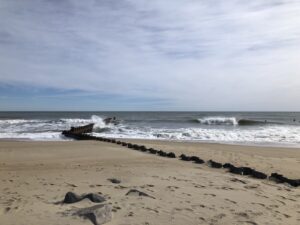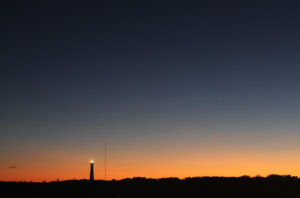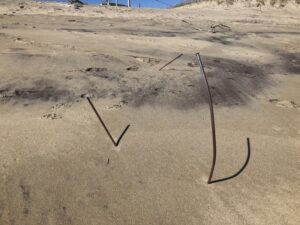First, let’s state the obvious: I’m homeless. Literally. I have no home, no (real) address, nothing of a permanent nature in my life. I have a mailing address (in the southern Massachusetts town of Randolph) with a mail-forwarding service where what few items of snail mail I still get are delivered, but I do NOT live in Randolph, that’s for sure. When I punch in the zip code into a gas pump to confirm that it’s my credit card, I still use the Plum Island number.
So with that mind, after my quick escape following the sale of my home in late November, I had no place to go. But at the same time, I had an infinite number of places to go—within pandemic limits, of course, which were/are substantial. That was a shame because, were it not for the pandemic, I’d have instantly jetted off to some far-flung locale as part of an ill-advised world debauchery tour. Instead, given said pandemic, I sought a place where I could hunker down in a safe, isolated setting yet still lead an active life.
I thought long and hard about heading to Puerto Escondido, Mexico, surfing each morning, taking Spanish lessons during the day and enjoying a very affordable cost of living. But stories coming out of Mexico, and Puerto in particular, painted a picture of COVID issues and crowded ICUs, and the thought of contracting the virus in a place where I couldn’t even speak the language was daunting. Hell, just the thought a long layover in Mexico City’s crowded airport was terrifying.
There weren’t many other airline-reachable destinations available to Americans thanks to our sterling response to the virus, so that left driving somewhere here in the United States. My old haunt of San Diego was enticing but the cost of living there is even more ridiculous than when I left almost five years ago. Another old haunt, the ski towns of the Rocky Mountains, seemed like a good call but the virus-inspired limitations at ski resorts made it apparent that the backcountry was going to be crowded, antithetical to the whole reason to forgo lift-assisted skiing. (That it turned out to be a poor winter for snow and a big winter for avalanche deaths in the backcountry made that a good call in hindsight.) And the lack of hockey to play, my unease at being in what used to be “home” and the notion of being cold with no apparent perks made New England not very appealing, despite a couple of offers from friends of free places to stay.
At that point, I opted for a somewhat familiar option: the Outer Banks of North Carolina. My thinking was that I’d have access to surfing and kiteboarding, and while cold, it wouldn’t be as cold as the conditions in New England. The somewhat warmer climate meant I could ride my bike and run more readily than up north as I attempted to get my fat ass back into post-COVID shape. I could also hunker down and get a lot of stuff done indoors: writing, first and foremost, along with extensive reading, Spanish study via the Rosetta Stone app and a lot of time spent practicing the banjo (seriously).
And while the outer edge of the Outer Banks was very appealing during the pandemic winter for its isolation, it wouldn’t be completely barren: a couple of supermarkets, a few restaurants and other infrastructure meant it wouldn’t be a case of camping out for several weeks.

The view from my bedroom didn’t suck…
I found a reasonably affordable place on AirBNB and rented it for four weeks—which I later extended for another four weeks. En route, I stopped at the Costco in Norfolk, Virginia, and stocked up on staples. And then I settled in to a cottage named “Cobia” in the village of Buxton, right at the corner where Hatteras Island turns from north-south to almost east-west and found myself literally in the shadow of the Cape Hatteras lighthouse.
And the place turned out to be a lot of what I had sought. Unfortunately, I turned out to be a lot of what I’d been. The combination resulted in the pandemic winter of 2020-2021 being a case where I really just treaded water. Some progress, but not enough. This is an accounting of those times.

…and the sunrises after the Winter Solstice moved noticeably northward
For starters, Cobia was perfectly located. The bedroom window gave me a view of the Atlantic Ocean at a surf break known as Lighthouse Third Groin. I could even see to the primary break located right in front of the lighthouse itself. That meant I could check conditions upon waking up and react accordingly. And even if there weren’t waves, I could go for walks on the beach right out my door. On top of that, Cobia was part of an old Navy (and then Coast Guard) base, and behind the unit was an old, elliptical roadway now serving as a parking area (empty during winter) that would be perfect for running intervals.
A short four-minute drive took me to a renowned kiteboarding spot on the Pamlico Sound side of the island known as Canadian Hole. Another spot that catered even more to beginner-level kiters was located about 20 minutes away in the village of Salvo.
And just a couple of minutes beyond Canadian Hole was the village of Avon, complete with a Food Lion supermarket, an Ace hardware store, a couple of restaurants including a sandwich shop, and also a coffee shop. Buxton itself had a great (but spendy) local supermarket, Conner’s, and a pizza joint that was pretty good. And south/west of Buxton were the villages of Frisco and Hatteras Village, the latter being the literal end of the road and site of a free car ferry to Ocracoke Island, a lovely, even more isolated section of the Outer Banks.

The main surf break is next to the first metal groin placed into the beach to protect the (now moved) Cape Hatteras Light
As for my actions, well, the first couple of surf sessions were complete debacles. For some reason, I couldn’t get out of my own way. I’d only been out of the water for a few weeks so I don’t think it was a case of me being completely out of it. And the water wasn’t too cold (by New England standards) yet so it wasn’t that. But for whatever reason, I wound up a bit gun-shy. I kept my efforts to the second and third groin breaks, preferring not to deal with the crowds at the lighthouse. And those breaks were more exposed than the one at the lighthouse, making for Plum Island-level arm-wasting currents whenever the wind blew. My third time out went better and I felt like I was getting back into a groove. Sadly, at that point, the swells kinda dried up—with the exception of one mega-swell in January that was only rideable at the lighthouse which, as I mentioned, I chose to avoid. As a result, I only surfed a few times during my entire stay.
As for kiteboarding: I had hoped to connect up with the place in the village of Waves where I’d taken a bunch of lessons over the years. In fact, I learned to kite at Real Watersports back in the fall of 2011. The thing is: I didn’t want to book a lesson too far in advance only to find that there was no wind; Real’s policy is not to issue refunds but instead to issue store credit, and I didn’t need any more gear. Not yet, anyway. And any attempt to book on short notice was unsuccessful, it being the off-season and there being a shortage of willing instructors.
I can kiteboard fine but I’ll never be good. My goal is to be a solidly intermediate kiter. Where I struggle is in launching and landing, steps that are ripe with opportunity for injury and damage. I finally screwed up the courage to go for it at the Salvo Day Use Area and actually launched and rode fine. The landing was another matter and it’s a miracle that I didn’t lose the kite. I figured out what I was doing wrong and while still a bit of a gong show, I managed to kite another couple of times, at both Salvo and Canadian Hole.
But the hoped-for regimen of almost-daily surfing and/or kiting never materialized. I had hoped to come out of my time on the Outer Banks having surfed almost as often as I did when I lived in San Diego, and to have kited just as frequently. That did not happen. What bothers me is that I don’t know why it was so. When surf conditions were favorable at Plum Island, I was ON it. There was no debate about temperature or wind or currents or crowds. I just WENT. But on Hatteras I was timid, and I’m bummed about that. I’m kinda thinking the fact that I was solo had something to do with it, but I’d go out solo in big, scary conditions at Plum Island all the time, so…you got me.
And my fitness regimen, well, that suffered a similar fate to my ocean-sports regimen, but that was simply a continuation of my fitness (non)regimen up north. I got out for one bike ride and actually ran a couple of times. I found a free yoga class online that was perfectly suited for my current fitness (or lack thereof). And I did a decent amount of seated meditation. But the daily activity did not materialize and that’s 100 percent on me. And I’m 100 percent bummed about it.
On the plus side of things, being in a decent house with a good kitchen meant I ate well, and in a mostly healthy manner. I ate most meals at home and made salads on a regular basis. I kept a pitcher of filtered water in the fridge and drank that and tea more than anything else.
And on the very positive side of things, probably the most positive development since the sale of my Plum Island home, is the fact that I stopped drinking alcohol. In fact, I had my last beer in my hotel room in Salisbury, Maryland, on December 14 on the way to the Outer Banks. I had wine with Christmas dinner and wine for New Year’s Eve, but since then and to this date in 2021, not a drop.
The net result of my continued inactivity and my decent food habits was pretty much a wash: I remain overweight (for me) and woefully out of shape (again, for me).
I did read a fair amount and played the banjo some (I am still very much a beginner). I did zero Spanish lessons and, as has been the case throughout much of my adult life, wrote far too infrequently. I think I’m the living embodiment of Thomas Mann’s observation that, “Writers are people for whom writing is more difficult than other people.” Or like the oft-noted observation about any number of fill-in-the-blank cities, I’m a permanent resident of the town that is “filled with musicians who don’t make music, actors who don’t act and writers who don’t write.” I am utterly perplexed and dejected about said realization. Indeed, this observation reaches deeply down into my very soul and is something I wrestle with literally every day of my life. My time on the Outer Banks was filled with such wrestling, such self-flagellation. Sadly, it wasn’t filled with writing.
As for my non-personal experiences, I found the Outer Banks to be a fascinating place, filled with wonderful discoveries and leading me to think that I could spend a lot more time there (during such off-seasons, not during high summer when the place is packed).

The conjunction of Jupiter and Saturn (barely visible at top center) was especially lovely in the dark skies of Cape Hatteras
The ocean and air teems with life even in winter, with critters I expected would have escaped to warmer climes. Dolphins swam in the surf and pelicans glided overhead daily. There was a neat forested area nearby, a feature I hadn’t expected for a barrier-beach island, that had several interesting (and empty) hikes/walks. Thanks to the lack of man-made light, the night sky on Hatteras Island is second-to-none on the East Coast, which made the rare conjunction of Jupiter and Saturn especially spectacular and full moons startlingly bright. And walking to the very point of Cape Hatteras—just down the beach a bit less than two miles from where I was staying—was fascinating. There you can witness where tendrils of two strong ocean currents collide: the Labrador Current sweeping down from the cold north and the Gulf Stream coming up from the tropics. The tumult of these two rivers running head-first into each other made for some wild-looking seas even on calm days and over millennia resulted in the Diamond Shoals shallows that stretch 22 miles out into the Atlantic, the so-called “Graveyard of the Atlantic.”
The history of the area, from the so-called “lost colony” of the 1500s on Roanoke Island to the Wright Brothers’ first flights to the naval battles of World War II, is also fascinating, and surprising for such a small, isolated area.

At lower tides, metal grounding bars were visible sticking out of the beach, evidence that homes once stood where waves now break. A harbinger of Plum Island’s future?
Other history of personal interest to me and my background on the barrier-beach island that is Plum Island was visible in the sandy beach right outside Cobia: at certain tides you could see sections of pavement, metal grounding bars, electrical cables and plumbing pipes sticking up through the sand, evidence that there once were houses and streets where now it was the beach. A small spike marks the spot where the Cape Hatteras Light once stood. After the metal groins placed into the beach to stabilize sand failed to protect the tower, an audacious (and very impressive in terms of engineering) effort was undertaken to move the tallest brick lighthouse in the United States a good quarter-mile or so back, out of reach (for now) of the Atlantic Ocean. But seeing all this clear evidence that the ocean WILL claim what is now man’s made me wonder about Plum Island’s future, something I’ve pondered since I was a kid. The evidence on display at Cape Hatteras should give one pause.
So yeah, my time on the Outer Banks was a mixed bag. In hindsight and from a surf and/or kite perspective, I probably should have gone to Puerto. It would have been cheaper, I’d have definitely surfed a lot more, but that would have meant zero kiting, zero banjo playing and profound health risk (maybe). Or San Diego had an epic winter for waves but the price tag would have been exorbitant and there were health risk there as well, what with crazy-crowded surfing lineups.
Instead, I spent extensive time in a new area that interested me on many levels. I’d like to go back and spend more time there, but if I don’t, well, I can say I’ve “done” the Outer Banks. And to have been there in the winter I believe gave me a more intimate view of the place, maybe more akin to what the locals know and love about the area. Any shortcomings from my time there are completely on me and, in fact, are not related to the place at all. In fact, I think I finally learned the lesson that, “No matter where you go, there you are.”



 The Ken Burns documentary on Ernest Hemingway ended a few minutes ago. I watched all three episodes when they aired and wouldn’t have missed it for the world. Check out my “
The Ken Burns documentary on Ernest Hemingway ended a few minutes ago. I watched all three episodes when they aired and wouldn’t have missed it for the world. Check out my “



